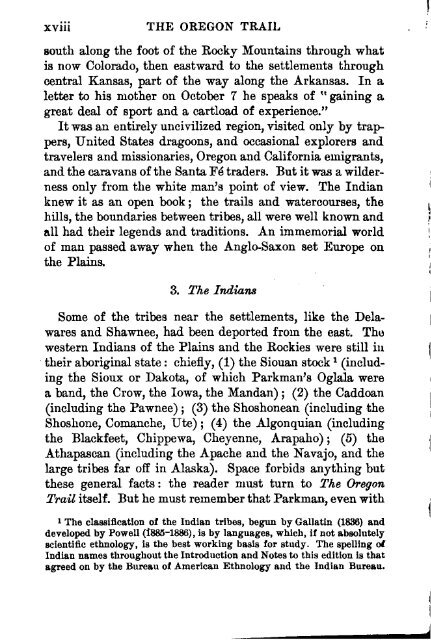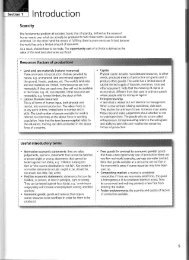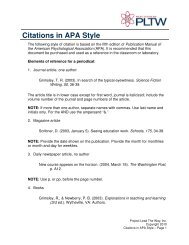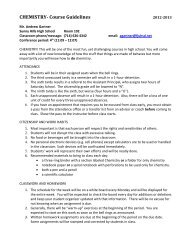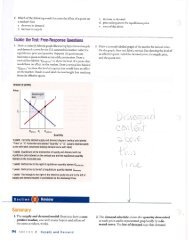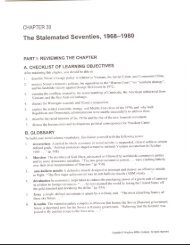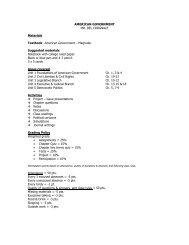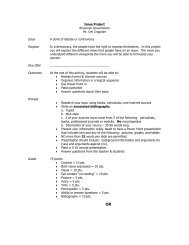- Page 3: THE OREGON TRAIL OF FRANCIS PARKMAN
- Page 6 and 7: PREFATORY NOTE This edition of The
- Page 8 and 9: INTRODUCTION FRANCIS PARKMAN: A GRE
- Page 10: INTRODUCTION xiii enough in middle
- Page 16: INTRODUCTION xix his keen eye for I
- Page 19 and 20: xxii THE -OREGON TRAIL of Iowa. A g
- Page 22 and 23: INTRODUCTION xxv the trade, and it
- Page 26 and 27: PREFACE TO THE FOURTH EDITION The f
- Page 28 and 29: PREFACE TO THE FOURTH EDITION xxxii
- Page 32: 2 THE OREGON TRAIL equipage was far
- Page 36: 6 THE OREGON TRAIL children's faces
- Page 44 and 45: 14 THE OREGON TRAIL half-civilized
- Page 46 and 47: 16 THE OREGON TRAIL Delawares. We c
- Page 49 and 50: CHAPTER III FORT LEAVENWORTH On the
- Page 51 and 52: FORT LEAVENWORTH 21 ,the Kickapoos,
- Page 53 and 54: CHAPTER IV "JUMPING OFF" Our transa
- Page 56 and 57: 26 THE OREGON TRAIL .. Drive on! dr
- Page 60 and 61: 30 THE OREGON TRAIL side to side th
- Page 63 and 64: JUMPING OFF" 33 word he spoke was a
- Page 65 and 66:
THE "BIG BLUE" 85 of us; and as we
- Page 67 and 68:
THE "BIG BLUE" stagnant pool into w
- Page 69 and 70:
THE .. BIG BLUE" 39 himself, and cl
- Page 71 and 72:
THE "BIG BLUE" 41 n Come on j we mu
- Page 73 and 74:
THE "BIG BLUE" 43 mules and horses.
- Page 76 and 77:
46 THE OREGON TRAIL Shaw' smiled j
- Page 78 and 79:
48 THE OREGON TRAIL who Wll8 in the
- Page 80 and 81:
50 THE OREGON TRAIL Riding up the l
- Page 85 and 86:
THE PLATTE AND THE DESERT 55 notabl
- Page 87:
THE PLATTE AND THE DESERT 57 unbrok
- Page 90 and 91:
CHAPTER VII THE BUFFALO Four days o
- Page 92:
62 THE OREGON TRAIL the outline of
- Page 96 and 97:
66 THE OREGON TRAIL I observed him
- Page 98:
68 THE OREGON TRAIL dismounted behi
- Page 101 and 102:
THE BUFFALO 71 green faces ofthe de
- Page 103 and 104:
THE BUFFALO 73 I find the above in
- Page 105 and 106:
TAKING FRENCH LEAVE 75 been plunder
- Page 108 and 109:
78 THE OREGON TRAIL " A very extrao
- Page 112 and 113:
82 THE OREGON TRAIL his chest and a
- Page 117 and 118:
TAKING FRENCH LEAVE 87 an easy post
- Page 119 and 120:
CHAPTER IX SCENES AT FORT LARAMIE L
- Page 121 and 122:
SCENES AT FORT LARAMIE 91 Fort Lara
- Page 123 and 124:
SCENES AT FORT I.ARAMIE 93 As we we
- Page 125 and 126:
SCENES AT FORT LARAMIE 95 an extemp
- Page 127:
SCENES AT FORT LARAMIE 97 that the
- Page 131 and 132:
SCENES AT FORT LARAMIE 101 his face
- Page 133:
CHAPTER X THE WAR-PARTIES The summe
- Page 138 and 139:
108 THE OREGON TRAIL Creek at the b
- Page 141:
THE W AR-PARTIES 111 according to c
- Page 144 and 145:
5 10 15 20 25 30 114 THE OREGON TRA
- Page 146:
116 THE OREGON TRAIL influence of a
- Page 149 and 150:
THE WAR-PARTIES 119 place, and I sh
- Page 151 and 152:
THE WAR-PARTIES 121 away on three l
- Page 153 and 154:
THE WAR-PARTIES 123 mere skeleton.
- Page 155 and 156:
CHAPTER XI SCENES AT THE CAMP Reyna
- Page 157 and 158:
SCENES AT THE CAMP 121 For that and
- Page 159 and 160:
SCENES AT THE CAMP 129 happy pail h
- Page 161 and 162:
SCENES AT THE CAMP 131 the village
- Page 163 and 164:
SCENES AT THE CAMP 133 either side
- Page 170:
140 THE OREGON TRAIL blanches, and
- Page 173:
CHAPTER XII ILL-LUCK A Canadian cam
- Page 176 and 177:
5 10 15 20 25 30 146 THE OREGON TRA
- Page 178 and 179:
148 THE OREGON TRAIL cord of hail'
- Page 181 and 182:
HUNTING INDIANS 151 appear in the c
- Page 183 and 184:
HUNTING INDIANS 153 The greater par
- Page 185 and 186:
HUNTING INDIANS 155 When noon came
- Page 187:
HUNTING INDIANS 151 exhausted, I le
- Page 191 and 192:
HUNTING INDIANS 161 I rode up to hi
- Page 193 and 194:
HUNTING INDIANS 168 decision, for w
- Page 195 and 196:
HUNTING INDIANS 165 insect called t
- Page 197 and 198:
HUNTING INDIANS 167 added with blun
- Page 199 and 200:
HUNTING INDIANS 169 fifty yards to
- Page 201 and 202:
HUNTING INDIANS 171 . Again we foun
- Page 203 and 204:
THE OGILLALLAH VILLAGE 173 overawed
- Page 205 and 206:
THE OGILLALLAH VILLAGE 175 So, stil
- Page 207 and 208:
THE OGILLALLAH VILLAGE 111 The lodg
- Page 209:
THE OGILLALLAH VILLAGE 179 the inha
- Page 212 and 213:
5 10 15 20 25 30 .182 THE OREGON TR
- Page 214 and 215:
184 THE OREGON TRAIL With the rough
- Page 216 and 217:
186 THE OREGON TRAIL Our encampment
- Page 218:
5 10 15 20 25 30 188 THE OREGON TRA
- Page 221 and 222:
THE OGILLALLAH VILLAGE 191 The shad
- Page 223 and 224:
CHAPTER XV THE HUNTING CAMP Long be
- Page 225 and 226:
THE HUNTING CAMP 195 we all went in
- Page 227 and 228:
THE HUNTING CAMP 197 The buffalo, a
- Page 229 and 230:
THE HUNTING CAMP 199 just alighting
- Page 231 and 232:
THE HUNTING CAMP 201 before had ass
- Page 233:
THE HUNTING,CAMP 203 hair from one
- Page 236 and 237:
206 THE OREGON TRAIL violently, and
- Page 238 and 239:
208 THE OREGON TRAIL sleeping. Ther
- Page 240:
210 THE OREGON TRAIL was exceedingl
- Page 243 and 244:
THE HUNTING CAMP 213 amicably, he t
- Page 245:
THE HUNTING CAMP 215 The White Shie
- Page 250 and 251:
220 THE OREGON TRAIL Hint and steel
- Page 253 and 254:
THE TRAPPERS 223 owing to a few of
- Page 255 and 256:
THE TRAPPERS 225 Indian village. Th
- Page 258 and 259:
228 THE OREGON TRAIL work. I assent
- Page 261 and 262:
A MOUNTAIN HUNT 231 one of the Indi
- Page 264:
234 THE OREGON TRAIL dull splash, b
- Page 268:
238 THE OREGON TRAIL Slowly, hour a
- Page 271:
A MOUNTAIN HUNT 241 the fancy, is u
- Page 274 and 275:
5 10 15 20 25 30 244 THE OREGON TRA
- Page 276 and 277:
246 THE OREGON TRAIL he gave over h
- Page 278 and 279:
248 THE OREGON TRAIL of the pool, a
- Page 280 and 281:
250 THE OREGON TRAIL ran at full sp
- Page 282 and 283:
5 10 15 20 25 30 252 THE OREGON TRA
- Page 284 and 285:
254 THE OREGON TRAIL .. We will 'ca
- Page 286 and 287:
256 THE OREGON TRAIL with a knife a
- Page 288 and 289:
5 10 15 20 25 30 258 THE OREGON TRA
- Page 290 and 291:
5 10 15 20 25 30 260 THE OREGON TRA
- Page 292:
262 THE OREGON TRAIL the Indian man
- Page 295 and 296:
THE LONELY JOURNEY 265 half white m
- Page 297 and 298:
THE LONELY JOURNEY 267 search that
- Page 299 and 300:
THE LONELY JOURNEY 269 direction an
- Page 303 and 304:
THE LONELY JOURNEY 273 We pushed th
- Page 305:
THE LONELY JOURNEY 275 transparent
- Page 310:
280 THE OREGON TRAIL .. Gentiles,"
- Page 313:
THE PUEBLO AND BENT'S FORT 283 Brid
- Page 319 and 320:
CHAPTER XXIII INDIAN ALARMS We bega
- Page 321:
INDIAN ALARMS 291 Only a day or two
- Page 326:
5 10 15 20 25 30 296 THE OREGON TRA
- Page 331:
THE CHASE 301 The chief difficulty
- Page 334 and 335:
5 10 15 20 25 30 304 THE OREGON TRA
- Page 336:
306 THE OREGON TRAIL In a moment I
- Page 339 and 340:
CHAPTER XXV THE BUFFALO CAMP No one
- Page 342:
312 THE OREGON TRAIL We meant to re
- Page 345 and 346:
THE BUFFALO CAMP 315 On the second
- Page 347:
THE BUFFALO CAMP 317 in the dust. A
- Page 351 and 352:
THE BUFFALO CAMP 321 in armor of in
- Page 354:
•, . ,l\. CHAPTER XXVI DOWN THE A
- Page 361:
DOWN THE ARKANSAS 331 roll over in
- Page 364:
334 THE OREGON TRAIL fell to the gr
- Page 369 and 370:
DOWN THE ARKANSAS 339 night, listen
- Page 374 and 375:
344 THE OREGON TRAIL From this time
- Page 376 and 377:
346 THE OREGON TRAIL We had passed
- Page 378 and 379:
348 'fliE OREGON TRAtL corner of th
- Page 380:
350 THE OREGON TRAIL trafIl.o acros
- Page 384:
354 THE OREGON TRAIL 89 1 Looking b
- Page 390:
860 THE OREGON TRAIL Sawin Ii.B man


